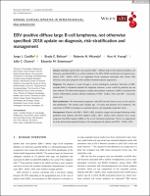EBV-positive diffuse large B-cell lymphoma, not otherwise specified: 2018 update on diagnosis, risk-stratification and management
Related Resource(s)
https://onlinelibrary.wiley.com/doi/full/10.1002/ajh.25112Date
2018-04Author(s)
Castillo, Jorge J.
Beltran, Brady E.
Miranda, Roberto N.
Young, Ken H.
Chavez, Julio C.
Sotomayor, Eduardo M.
Metadata
Show full item recordAlternate title
Linfoma difuso de células B grandes positivo para EBV, no especificado de otra manera: actualización de 2018 sobre diagnóstico, estratificación de riesgo y manejo
Abstract
El linfoma difuso de células B grandes (LDCBG) positivo al VEB, no especificado de otra manera (NOS) es un subtipo de linfoma agresivo poco común asociado con un peor pronóstico en los ancianos. Se ha informado DLBCL positivo para EBV en <5% de los pacientes occidentales sin inmunodeficiencia predisponente documentada. Existen muchos trastornos linfoproliferativos asociados con la infección por VEB, como granulomatosis linfomatoide, linfoma plasmablástico, LDCBG asociado con inflamación crónica, úlcera mucocutánea positiva para VEB, linfoma de derrame primario y linfoma de Hodgkin clásico. El LDCBG EBV-positivo, NOS es un diagnóstico de exclusión y se requiere una correlación clínico-patológica para diferenciar entre estos diagnósticos diferenciales. Los pacientes con enfermedad inflamatoria intestinal (EII) que reciben medicamentos inmunosupresores tienen un mayor riesgo de desarrollar linfomas de Hodgkin y no Hodgkin y se ha informado VEB en ambos. A continuación, presentamos un caso de LDCBG EBV positivo, NOS que afecta la pared intestinal asociada con perforación y afectación parcial de un ganglio linfático en un hombre de 73 años con enfermedad de Crohn. Disease overview: Epstein Barr virus-positive (EBV1) diffuse large B-cell lymphoma (DLBCL), not
otherwise specified (NOS) is an entity included in the 2016 WHO classification of lymphoid neoplasms. EBV1 DLBCL, NOS, is an aggressive B-cell lymphoma associated with chronic EBV
infection, and a poor prognosis with standard chemotherapeutic approaches.
Diagnosis: The diagnosis is made through a careful pathological evaluation. Detection of EBVencoded RNA is considered standard for diagnosis; however, a clear cutoff for positivity has not
been defined. The differential diagnosis includes plasmablastic lymphoma, DLBCL associated with
chronic inflammation, primary effusion lymphoma, HHV81 DLBCL, NOS, and EBV1 mucocutaneuos ulcer.
Risk-stratification: The International prognostic index (IPI) and the Oyama score can be used for
risk-stratification. The Oyama score includes age >70 years and presence of B symptoms. The
expression of CD30 is emerging as a potential adverse, and targetable, prognostic factor.
Management: Patients with EBV1 DLBCL, NOS, should be staged and managed following similar
guidelines than patients with EBV-negative DLBCL. EBV1 DLBCL, NOS, however, has a worse
prognosis than EBV-negative DLBCL in the era of chemoimmunotherapy. There is an opportunity
to study and develop targeted therapy in the management of patients with EBV1 DLBCL, NOS.
Collections
- Artículos científicos [890]






